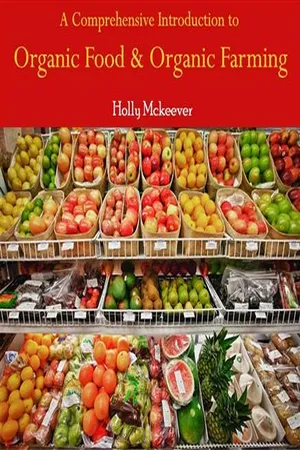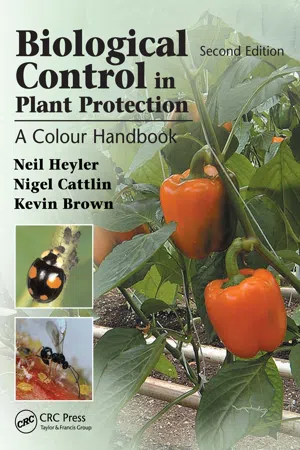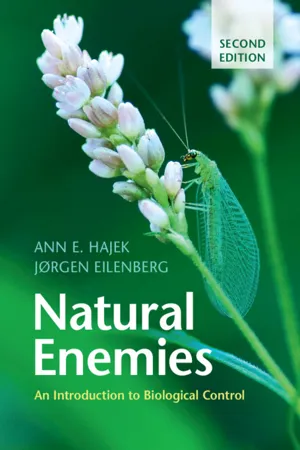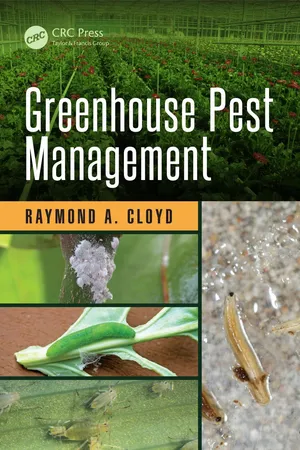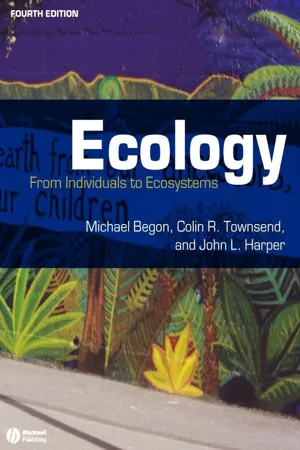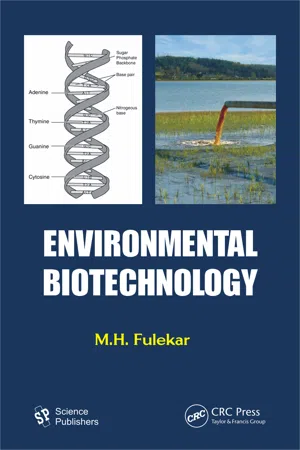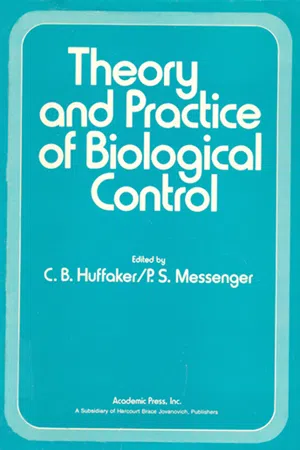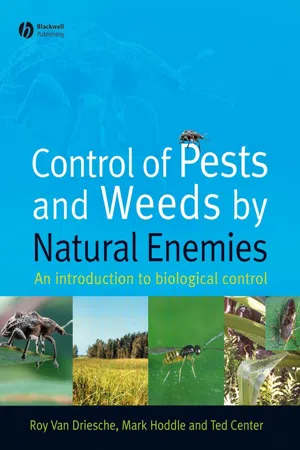Geography
Biological Pest Control
Biological pest control involves using living organisms, such as predators, parasites, or pathogens, to manage and reduce pest populations. This method is a sustainable and environmentally friendly approach to pest management, as it minimizes the use of chemical pesticides and promotes natural ecological balances. Biological pest control can help maintain the health and productivity of agricultural and natural ecosystems.
Written by Perlego with AI-assistance
Related key terms
1 of 5
10 Key excerpts on "Biological Pest Control"
- eBook - PDF
Pests Of Vegetables
Bionomics And Management
- Laskar, Nripendra(Authors)
- 2020(Publication Date)
- NEW INDIA PUBLISHING AGENCY (NIPA)(Publisher)
Biological control agents Biological control is the use of living organisms to suppress the pest populations, making them less damaging than they would otherwise be. Biological control can be used against all types of pests, including vertebrates, plant pathogens and weeds as well as insects. The methods and agents used are different for each type of pest. Pests are species that attack some resource we want to protect, and do it well enough that they cause losses or are a major annoyance. Pests are only a tiny fraction of the insect species around us. Many pest species only occasionally do real damage. Natural enemies play an important role in limiting potential pest populations. We have seen what happens when pesticides devastate the natural enemies of potential pests. Insects that were of little economic importance can become damaging pests. When non-toxic control method is used, natural enemies are more likely to survive and reduce the numbers and damage of potential pest species. There are three categories of natural enemies of insect pests; predators, parasitoids and pathogens. a. Predators Many kinds of predators feed on insects. Insects are an important food for many vertebrates, including birds, amphibians, reptiles, fish and mammals. These insectivorous vertebrates usually feed on many insect species and rarely focus on specific pests, unless they are very abundant. Insects and related predators are more often used in biological control because they feed on a smaller range of prey species. These predators, with their shorter lifecycle, may also fluctuate in population density in response to changes in the density of their prey. Predators 471 Biological Control in Vegetable Pest Management are mainly free-living species that directly consume a large number of preys during their whole lifetime. Important insect predators include lady beetles, ground beetles, rove beetles, flower bugs and other predatory true bugs, lacewings and hover flies. - No longer available |Learn more
- (Author)
- 2014(Publication Date)
- Library Press(Publisher)
________________________ WORLD TECHNOLOGIES ________________________ Chapter- 8 Biological Pest Control Biological control of pests in agriculture is a method of controlling pests (including insects, mites, weeds and plant diseases) that relies on predation, parasitism, herbivory, or other natural mechanisms. It can be an important component of integrated pest mana-gement (IPM) programs. Biological control is defined as the reduction of pest populations by natural enemies and typically involves an active human role. Natural enemies of insect pests, also known as biological log control agents; and include predators, parasitoids, and pathogens. Biolo-gical control agents of plant diseases are most often referred to as antagonists. Biological control agents of weeds include herbivores and plant pathogens. Predators, such as birds, lady beetles and lacewings, are mainly free-living species that consume a large number of prey during their whole lifetime. Parasitoids are species whose immature develops on paper or within a single insect host, ultimately killing the host. Most have a very narrow host range. Many species of wasps and some flies are parasitoids. Pathogens are disease-causing organisms including bacteria, fungi, and viruses. They kill or debilitate their own host and are relatively specific. There are three basic types of biological control strategies; conservation, classical biological control, and augmentation. Conservation The conservation of natural enemies is probably the most important and readily available biological control practice available to homeowners and gardeners. Natural enemies oc-cur in all areas, from the private garden to the open field. They are adapted to the habitat and to the target pest, and their conservation is generally simple and cost-effective. Lacewings, lady beetles, hover fly larvae, and parasitized aphid mummies are almost always present in aphid colonies. - eBook - PDF
Biological Control in Plant Protection
A Colour Handbook, Second Edition
- Neil Helyer, Nigel D. Cattlin, Kevin C. Brown(Authors)
- 2014(Publication Date)
- CRC Press(Publisher)
INTRODUCTION Biological control can be defined as the control of pests or pathogens by other organisms. The introduction of a biocontrol agent is aimed at reducing the population of the pest or pathogen to below an economic damage threshold for that particular crop. But biological interactions occur naturally, and it is through the effects of these that plant and animal populations are regulated and generally kept in balance (Figure 6.1). Our agricultural practices that produce vast monocrop areas distort this balance in favor of the crop plant, which may increase the attack by host-specific herbivores and disease (Figure 6.2). The introduction of bio-control agents is used to reduce the serious-ness of these attacks and maintain a plant population at a higher density than would occur in the wild. Biocontrol is an exercise in population management and with it goes the responsibility of understanding the possible effects on nontarget populations. In this chapter some of these interactions are considered and the possible mechanisms of biocontrol discussed. CLASSICAL BIOLOGICAL CONTROL— FOREIGN PLANTS Our increasing ability to cross the world in less than a day and source our food from faraway places means that some animals and plants that have evolved separately on each continent in different ecological communities for some 60 million years can be introduced into new habitats. One possible consequence of this is that the introductions can cause a major problem because the natural agents that regulate them are not present. There are a number of well documented examples of problems resulting from the introduction of plants that have subsequently been con-trolled by the use of imported biocontrol agents. An ornamental prickly pear cactus ( Opuntia stricta ), originally from South America and Biological control in perspective Dr. Mike Copland WyeBugs, Wye Campus Imperial College, London CHAPTER 6 207 Classical Biological Control—Foreign Plants - eBook - PDF
Natural Enemies
An Introduction to Biological Control
- Ann E. Hajek, Jørgen Eilenberg(Authors)
- 2018(Publication Date)
- Cambridge University Press(Publisher)
Part III Biological Control of Invertebrate and Vertebrate Pests 6 Ecological Basis for Use of Predators, Parasitoids, and Pathogens to Control Pests Ecology may be the most intractable legitimate science ever developed. (Slobodkin, 1988) The ultimate goal of biological control is to manipulate systems to maintain populations of potential pests at low densities and thus prevent problems that they might cause. It follows that biological control in ecosystems can be thought of as a type of applied population ecology. In fact, natural enemies and their hosts have been the basis for many ecological studies investigating how populations are regulated. The field of ecology has gained from such studies which have been the basis of ecological theories. There is also a strong movement to use insights gained from ecological theory to help increase the success of biological control. Different natural enemies to be used for biological control, as well as the diverse pests they attack, can have very different biologies. A basis for evaluating the spectrum of differences in species can be how fast they increase in numbers versus their long-term persistence in a competitive environment. The r-selected species increase very quickly but are not well known for persisting in an area. A great example would be an inva- sive weed species that is good at rapidly colonizing new habitats. At the other end of the spectrum, K-selected species are better competitors in communities and persist well in established ecosystems (Table 6.1). Looking at organisms along the r–K continuum provides an example of the kinds of characteristics that must be evaluated when consid- ering how to control a pest, as well as when evaluating natural enemies to be used for pest control. For example, those lady beetles developing faster than their scale insect prey provide better control as opposed to lady beetles eating aphid prey that develop much faster than the lady beetles (see Section 7.2.1). - eBook - PDF
- Raymond A. Cloyd(Author)
- 2016(Publication Date)
- CRC Press(Publisher)
141 Chapter 7 Biological Control A biological approach involves using natural enemies (or biological control agents) such as parasitoids (parasitic wasps), predators, and/or pathogens (entomopathogenic nematodes and fungi) to suppress or regulate insect and mite pest populations in greenhouses. It is important to under- stand that biological control is a regulatory process; natural enemies will not eradicate an insect or mite pest population. The success of natural enemies is based primarily on their ability to maintain insect or mite pest numbers at levels low enough to minimize plant damage and subsequently main- tain their own populations. The reason why greenhouse producers are interested in implementing a biological control program is due to issues associated with pesticide resistance, in which the efficacy of a given pesticide that targets a par- ticular insect and/or mite pest population is substantially less than what was obtained previously. However, there is a gen- eral perception that biological control costs more than using pesticides, although this is not necessarily the case. When factors such a resistance, disposal, worker safety, and plant safety associated with pesticides are taken into consideration then biological control may actually be less expensive than pesticides. 142 ◾ Greenhouse Pest Management The advantages of implementing a biological control program in greenhouses are: (1) fewer worker and customer exposure risks associated with pesticide residues on plants, (2) fewer rules and regulations (compared to pesticides), (3) no plant injury (such as phytotoxicity) or safety issues, (4) no issues affiliated with pesticide resistance, (5) minimal equipment required for application, and (6) marginal cleanup needed after application. - eBook - PDF
Ecology
From Individuals to Ecosystems
- Michael Begon, Colin R. Townsend, John L. Harper(Authors)
- 2009(Publication Date)
- Wiley-Blackwell(Publisher)
This is a case of a desired invasion of an exotic species and is often called classical biological control or importation. By contrast, conservation biological control involves manipula- tions that augment the density or persistence of populations of generalist natural enemies that are native to the pest’s new area (Barbosa, 1998). Inoculation is similar to introduction, but requires the periodic release of a control agent where it is unable to persist through- out the year, with the aim of providing control for only one or perhaps a few generations. A variation on the theme of inoculation is ‘augmentation’, which involves the release of an indigenous natural enemy in order to supplement an existing population, and is also therefore carried out repeatedly, typically to intercept a period of rapid pest population growth. Finally, inundation is the release of large numbers of a natural enemy, with the aim of killing those pests present at the time, but with no expectation of providing long-term control as a result of the control agent’s population increasing or maintaining itself. By analogy with the use of chemicals, agents used in this way are referred to as biological pesticides. Insects have been the main agents of biological control against both insect pests (where parasitoids have been particularly useful) and weeds. Table 15.3 summarizes the extent to which they have been used and the proportion of cases where the establishment of an agent has greatly reduced or eliminated the need for other control measures (Waage & Greathead, 1988). Probably the best example of ‘classical’ biological control is itself a classic. Its success marked the start of biological control in a modern sense. The cottony cushion scale insect, Icerya purchasi, was first discovered as a pest of Californian citrus orchards in 1868. By 1886 it had brought the citrus industry close to the point of destruction. - eBook - PDF
- William W. Murdoch, Cheryl J. Briggs, Roger M. Nisbet(Authors)
- 2013(Publication Date)
- Princeton University Press(Publisher)
C H A P T E R N I N E Implications for Biological Control Here we synthesize results, mainly from chapters 8 and 10, that relate to biological control, and where possible relate them to real systems. Mostly we consider “classical” biological control in which the pest is an alien species and the specialist natural enemies released to control it have typically been found in the pest’s region of origin. Such control has been most successful in long-lived crops such as forests and orchards, and this is where most of our models, with their long-term view, are relevant. But we also consider, briefly, temporary environments such as seasonal crops, where indigenous enemies are typically important. We comment only briefly on generalist enemies since the book does not deal with relevant theory (Holt and Lawton 1993; Murdoch et al. 1998a; Chang and Kareiva 1999). Hawkins and Cornell (1999) provide a wide-ranging summary of current theory for biological control and a good entry into the literature. In spite of its successes, and its more numerous failures, there are few, if any, general principles, or even rules of thumb, to guide the efforts biological control. Nor is there a general scientific basis for biological control. There seem to be several reasons for this. First, success or failure depends on the detailed natural history of each situation, and these details vary in uncountable ways from one system to another. Second, there has been astonishingly little effort to learn from more than 100 years of experience. If a natural enemy works to control a pest somewhere, the entomologist must move on to the next problem; if it fails, the entomologist tries another enemy or moves on to the next problem. There has been little support for analyzing in the field the conditions separating success and failure. Biological control has thus been an unrelenting trial-and-error pro-cess over its entire history. Whether theory can inform this process - eBook - PDF
- M. H. Fulekar(Author)
- 2010(Publication Date)
- CRC Press(Publisher)
Seasonal inoculative release of insect parasitoids and predators has been a highly successful strategy for biological control in European greenhouses. This strategy was adopted by growers because of pests’ resistance to insecticides, and the rising costs of chemical control. The programme was originally built around use of the parasitoid Encarsia formosa against the greenhouse whitefly and the predacious mite Phytoseiulus persimilis against the two-spotted spider mite. Over the years, additional natural enemies have been added to control other pests, such as thrips, leafminers, aphids, caterpillars and other whitefly species. Biological control costs are now much lower in Europe than chemical control costs. Growers learn about programmes, new developments and new natural enemies through a network of extension advisers, specialized journals and grower study groups. 404 Environmental Biotechnology Another example of seasonal inoculative release in the field is the use of the parasitic wasp, Pediobius foveolatus against Mexican bean beetles. These parasitoids cannot survive Northeast winters. However, they can be reared in the laboratory and released annually, where they multiply, killing their hosts throughout the season. They are reared and released and are also commercially available. 14.8.6 Relationship of Biological Control to Sustainable Agriculture Native biological control agents and introduced natural enemies, once they are established in the environment, are a self-renewing resource. They multiply themselves by feeding on pests. They cost only whatever expenses may have been incurred in encouraging them and enhancing the environment so they may flourish. As long as one can sustain them, they will help to sustain the agricultural system. Because this form of biological control is seldom dramatic and obvious, its benefits often escape recognition. - eBook - PDF
- C.B. Huffaker(Author)
- 2012(Publication Date)
- Academic Press(Publisher)
The degree of this success and the probability of achieving new successes is a matter also of economics. Thus, the economics of biological control is also dealt with in this chapter, and a table listing the results on a worldwide basis is given as an Appendix as a sugges-tion of further possibilities. II. NATURAL CONTROL A N D THE BALANCE OF NATURE The concept of natural control derives from the observation that, in general, popula-tions of organisms in nature commonly exhibit a considerable stability in their space— time relationships. MacFadyen (1957) stated, It is generally agreed that the same species are found in the same habitats at the same seasons for many years in succession and that they occur in numbers which are of the same order of magnitude. The term * 'balance of nature implies a stability of numbers, although it is obvious that popula-tions continually undergo changes in density, e.g., as related to mortality factors and to reproductive and nonreproductive periods. Thus, insect populations are characterized by inherent stability, on the one hand, and by recurrent fluctuations, on the other. Smith (1935) characterized this in the idea that population densities are continually changing but that they tend to vary about a mean which is comparatively stable although itself subject to change. The more diverse the natural communities, the greater the range of compensations in preventing drastic upsets when controlling agents which are specific over certain ranges of host density may temporarily lose their role. Here we wish to explore this process of natural control. The subject has long been one of considerable debate, but in the last decade rather more agreement has come about. - eBook - PDF
Control of Pests and Weeds by Natural Enemies
An Introduction to Biological Control
- Roy van Driesche, Mark Hoddle, Ted Center(Authors)
- 2009(Publication Date)
- Wiley-Blackwell(Publisher)
These increasing demands for compre-hensive knowledge about both the target weed and the agents proposed for release make small programs of weed biological control difficult and potentially irre-sponsible. However, most biological control programs do not follow a linear sequence of steps, such as described in the literature (e.g. Wapshere et al. 1989). More often, they require adaptive management in which goals are set according to a general strategy but with a learning plan such that the prescribed steps can be altered as knowledge increases and uncertainty decreases (McFadyen 2000). The adaptive approach allows the efficient use of human and material resources, which are often limiting. Projects should be done in their entirety, including follow-up evaluations. Commitments should be sought at the outset to ensure that project evaluations are included as part of an overall funding package. Follow-up should include non-target and food-web effects as well as evaluations of the efficacy of the agents, both individually and collectively. Chapter 12 Weed biological control 147 Part 5 TOOLS FOR CLASSICAL BIOLOGICAL CONTROL Chapter 13 FOREIGN EXPLORATION For invasive plants, the species itself may be well known but may have an extremely large range, with unclear genetic relatedness among geographic popula-tions, making it difficult to select priority areas for nat-ural enemy collection. Also, the invasive population of a pest may include several species or hybrids derived in complex ways from several parent species. For exam-ple, saltcedars ( Tamarix spp.) invasive in the southwest-ern USA consist of four species and their hybrids (DeLoach et al. 2003). The parent species of the pest populations have a collective native range that extends from North Africa to China (Milbrath & DeLoach 2006). Molecular analyses (see Chapter 15) can unravel such relationships and help identify which locations might be the best to search for natural enemies.
Index pages curate the most relevant extracts from our library of academic textbooks. They’ve been created using an in-house natural language model (NLM), each adding context and meaning to key research topics.

